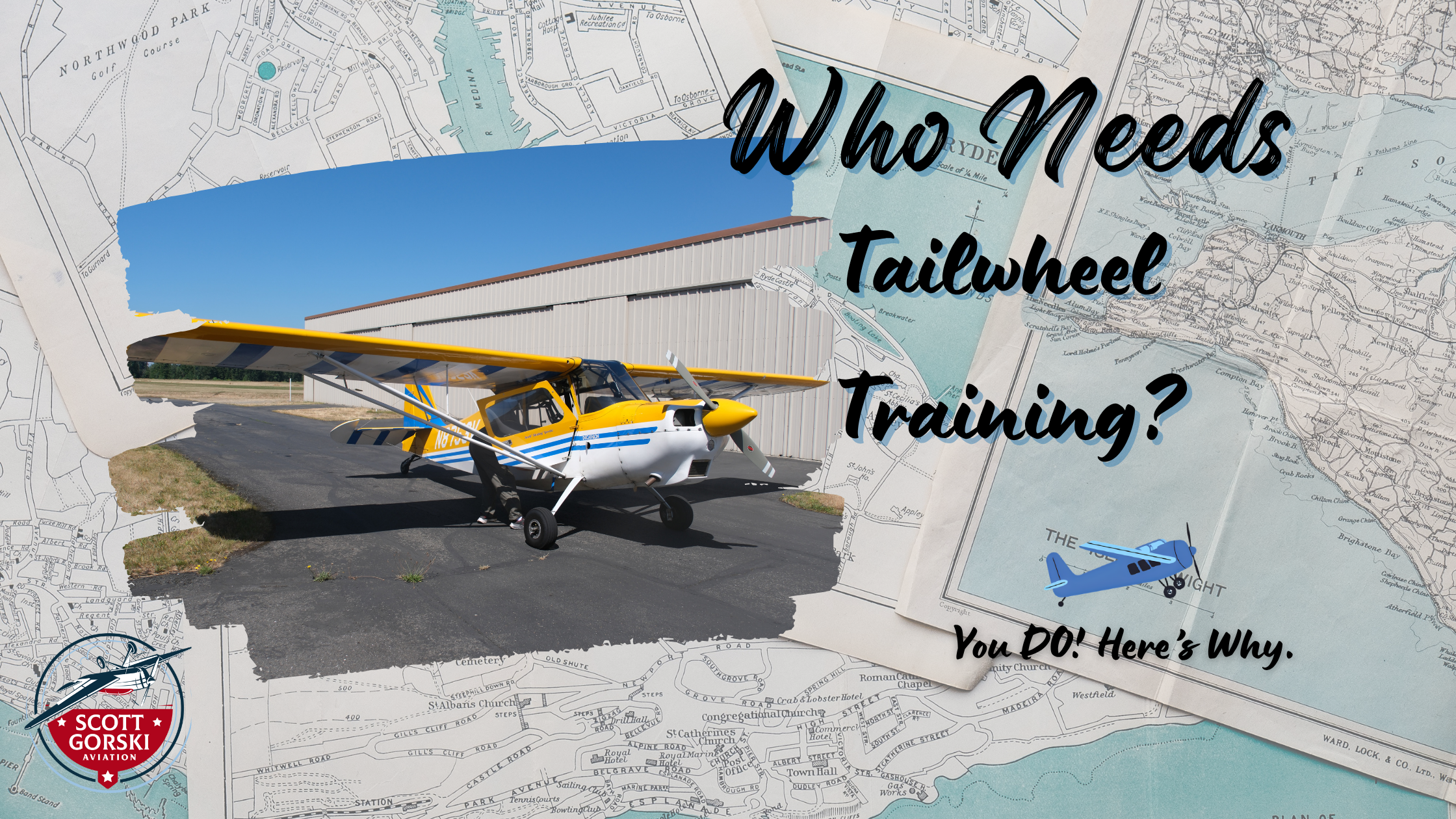Who needs tailwheel training? You Do! (And here’s why.)

Back in the early days of aviation, all airplanes were taildraggers. They were called taildraggers because they didn’t even have a wheel. Many of the early planes just had a skid plate that dragged on the ground. This is also why tailwheel airplanes are referred to as having conventional gear as opposed to tricycle gear.
Tailwheel airplanes are notoriously finicky on landing and many a ground loop has occurred for many reasons your CFI has yelled at you about during training. (i.e. sideloaded landings, poor rudder control, improper round out and flare etc.) After WWII, airplane designers started making tricycle gear airplanes because that configuration is much more stable.
In early GA, most training was still done in post-war tailwheel airplanes. Fun fact, the reason you get your shirt tail cut after you solo is because the only way an instructor could get their students attention in an open cockpit with no intercom, was to tug on their shirt. The cutting of the shirt is a symbol of freedom from the instructor, much like cutting the proverbial apron strings.
In the 60’s and 70’s Cessna came along with their very stable 150, 152, and 172 platforms still in use across many flight schools today. These airplanes are great for initial flight training because they can absorb the punishment that students dish out without biting back. Unfortunately this allows bad habits to form, which brings me to my point of why you need tailwheel training.
Tailwheel training will bring you back to the stick and rudder days of yore. Tailwheel training at Scott Gorski Aviation Aerobatics will teach you more than just how to take off and land in a conventional-gear airplane. You will also learn how to really fly like they did in the old days using visual references and looking out of the airplane instead of inside.
Getting your tailwheel endorsement will teach you greater precision of control in turns so you can start and stop turns on a dime. This skill is very useful if your dream is to learn backcountry flying or aerobatic flying. In flight school, you were taught to smoothly blend stick and rudder for turns, which is absolutely correct for primary training. Tailwheel training program will teach you how to safely use flight controls independent of each other to make you the true master of your airplane.
Tailwheel training will make you a better lander of the airplane. Every single student I have trained over the years has had the same bad habits that need to be overcome. In a Cessna, you get the luxury of coming in at 65 knots with 30 degrees of flaps at 1500 rpm. You get to your round out and flare, chop the throttle, and pull back until the wheels touch. It doesn’t matter if you are sideloaded because the tricycle gear will pull you back online. Try that in a Pitts and you will be going on Mr. Toad’s wild ride to a ground loop. Every student I have given a tailwheel endorsement to has admitted to me that they are much better at landing their airplanes because of our tailwheel training. Not only that, it has improved their ground handling and airmanship skills.
My Decathlon does not have flaps, so approaches seem higher and flatter than you are used to. In a Cessna, you can keep pulling to a stall because of the gear configuration. You can’t do that in a tailwheel airplane because you will strike the tailwheel. The discipline learned during tailwheel training will reap benefits that will seep into all aspects of your future flying. You will learn how to time out your round out and flares with greater precision, making sure that you are longitudinally aligned with the runway. You will learn how to fly the airplane all the way to a stop.
The reason they make you do a stop and go for tailwheel training instead of a touch and go is because once the wheels touch, you are not done until the plane comes to a stop. Once the wheels touch, the fun begins. You need to maintain “happy feet” to keep the plane aligned even after landing. A Cessna does not react much to the negative P-factor of pulling power to idle but it does in a tailwheel plane.
A common error for many students during tailwheel training is to relax once they touch down. They then start swerving and over-control the plane. This is what leads to ground loops. Much like driving on snow and ice, it’s not the first swerve that gets you, it’s the overcorrection, and the second loop takes you around. The discipline learned during practice will make your attention and concentration greater for all future flights. These skills may also save your life when (God forbid) you ever have an emergency that leads to an off-field landing.
I have also noticed that many students look too closely over the spinner while landing. This is another bad habit encouraged by flying Cessnas because a “good” landing in a Cessna ends with you not being able to see the end of the runway because of the flare. During tailwheel training, you will learn how to use a combination of power and pitch to bring an airplane in for a perfect no-flap landing, which will also be useful in an emergency if you lose power in your plane and are unable to deploy flaps.
Even if you never intend to buy or regularly fly a tailwheel gear airplane, tailwheel training will increase your overall skill set and help you become a better pilot. You can fly an airplane with greater confidence knowing you have the ability to better control your airplane during regular flight and during emergencies. Pilots with seaplane ratings tend to do well during tailwheel training because many of the tenets are the same. Go look up the technique for glassy-water landings, and you’ll see what I mean.
Ultimately, tailwheel training is essential for every pilot. The skills acquired will help you with your everyday flying. You will learn how to be more precise with your stick and rudder skills. You will learn how to do excellent takeoffs and landings, including short-field, soft-field, and power-off 180 landings.
Come see me at Scott Gorski Aviation Aerobatics and train to be a better pilot today.

Scott Gorski is a former Navy crew member who rekindled his passion for flying after 20 years and now teaches various forms of flight training, including tailwheel, Roll/Upset, and competition acrobatics. He competes regularly and is part of the IAC chapter 67.

